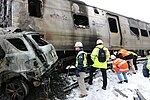Westchester Medical Center

Westchester Medical Center University Hospital (WMC), formerly Grasslands Hospital, is an 895-bed Regional Trauma Center providing health services to residents of the Hudson Valley, northern New Jersey, and southern Connecticut. It is known for having one of the highest case mix index rates of all hospitals in the United States. 652 beds are at the hospital's primary location in Valhalla, while the other 243 beds are at the MidHudson Regional Hospital campus in Poughkeepsie. It is organized as Westchester County Health Care Corporation, and is a New York State public-benefit corporation.Westchester Medical Center is the primary academic medical center and University Hospital of New York Medical College. Many of New York Medical College's faculty provide patient care, teach, and conduct research at the adjacent campus. Westchester Medical Center provides diverse specialty services to patients of all ages, and hosts one of the leading Kidney and Liver transplant programs in New York, and is home to Maria Fareri Children's Hospital, the only all-specialty children's hospital in the region.
Excerpt from the Wikipedia article Westchester Medical Center (License: CC BY-SA 3.0, Authors, Images).Westchester Medical Center
Woods Road,
Geographical coordinates (GPS) Address Phone number Website External links Nearby Places Show on map
Geographical coordinates (GPS)
| Latitude | Longitude |
|---|---|
| N 41.086133 ° | E -73.8054204 ° |
Address
Westchester Medical Center
Woods Road 100
10595
New York, United States
Open on Google Maps






